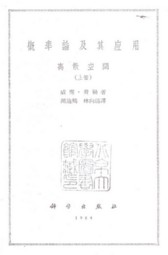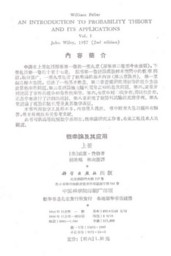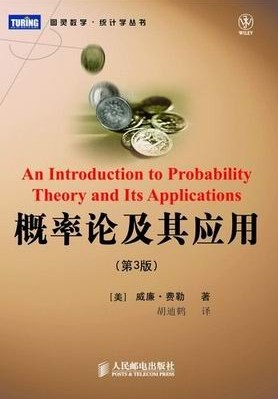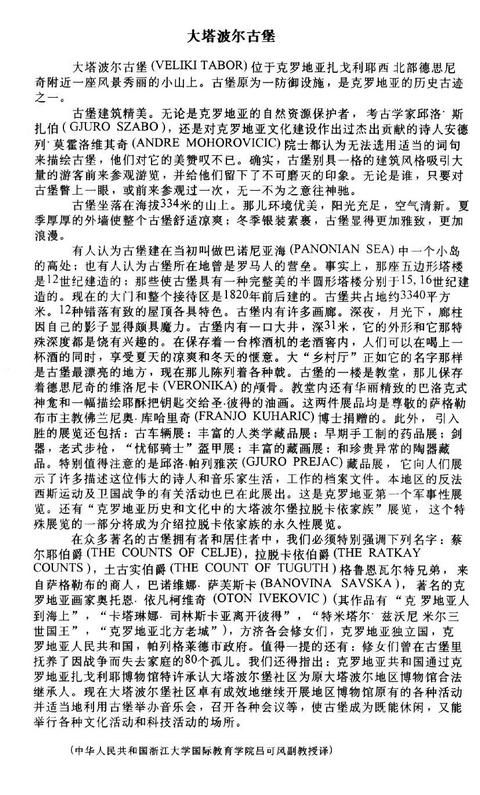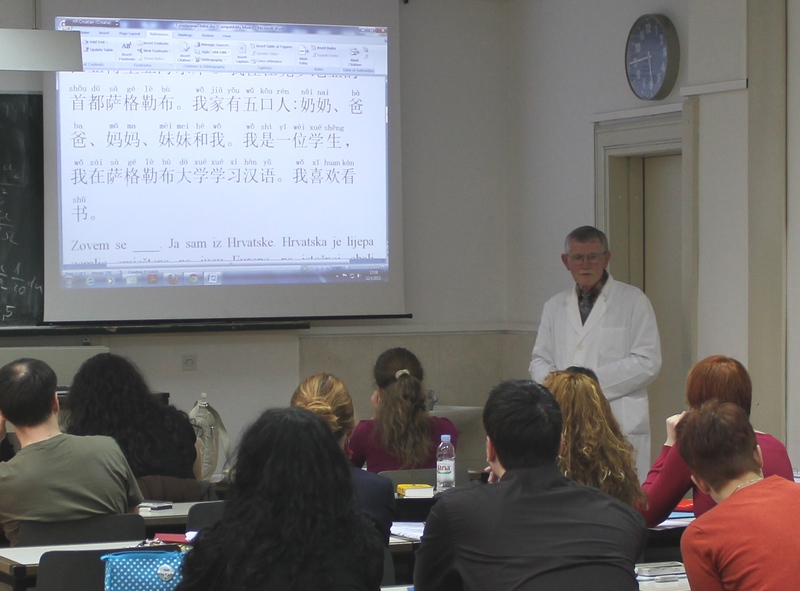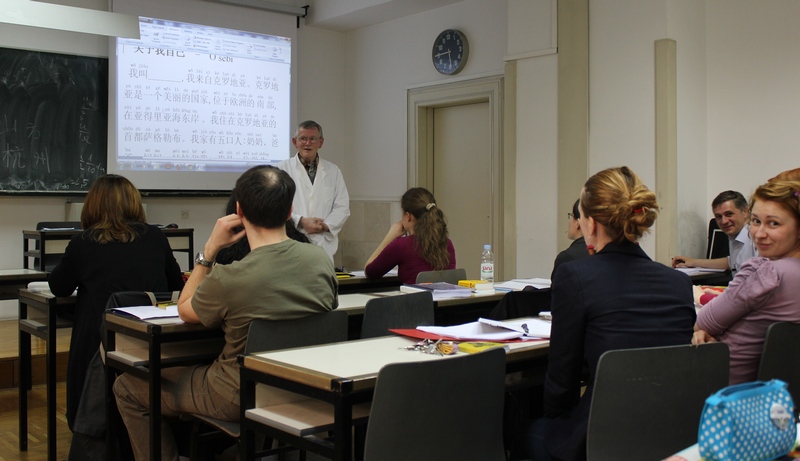Croatia - China

    |
    |
Croatia
| Title | Characters
Simplified
Traditional |
Various forms of Romanized Chinese | |
| Croatia | 克
罗 地 亚 克 羅 地 亞 |
kè
luó dì yà ke luo di ya k`o lo ti ya |
ke4
luo2 di4 ya4 keluodiya kolotiya ko lo ti ya |
Ivan (Juan) Vucetic (1858-1925), distinguished Croatian scientist who introduced the method of scientific dactyloscopy
(identification of persons by fingerprints) in Argentina, visited China
in 1910, and popularized this method there, especially for the needs of
the police research. He was spreading this method also when he visited
Japan.
Professor Andrija Stampar (1888-1958) was our leading authority in the field of epidemiology and a pioneer in preventive medicine. After the assassination of Stjepan Radic in the Belgrade Parliament in 1928 and the dictatorship of king Alexandar he refused to enter the government of the then Yugoslavia. Since he was forcefully retired at the age of 42, he decided to go abroad, see [Lang, p 16]. As an expert of the League of Nations he spent three years (1933-1936) in China, developing the health service there. During the WW2 he was arrested by the German Nazis and kept in custody in Graz in Austria. He was one of the founders of the World Health Organization (WHO) and very active in promoting the health service in Afghanistan, Egypt, Sudan and Ethiopia. He wrote the introductory declaration of the Statute of the WHO and was the first president of this organization. In 1948 Andrija Stampar was the chairman of the first WHO General Assembly in Geneva.

In 1955 he was awarded the medal of Leon Bernard, which is the most prestigious international acknowledgement in the field of social medicine. For more details see his book The first ten years of the World Health Organization, Geneva, 1958. Each year since 1993, during its Annual Conference, the Association of Schools of Public Health in Europe (ASPHER) awards the prestigious Andrija Stampar Medal to a distinguished person for excellence in the field of Public Health.
Source: Croatian Medicine
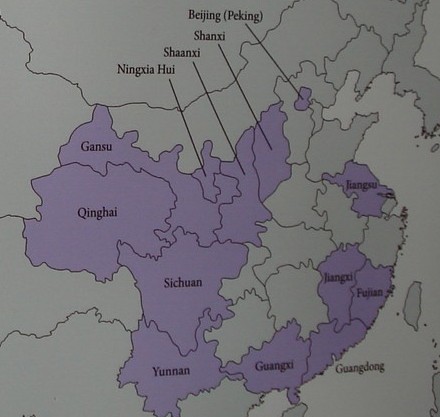
Chinese provinces visited by Andrija Štampar in 1930s as a representative of the then League of Nations

Wonderful recognition to Andrija Štampar from the Central Chinese Government as a sign of their gratitude and appreciation.
| ...
The Secretary General of the
League of Nations, in a letter of August 30, 1933, asked
Štampar
to be 'the League expert on health matters to be put at the disposal of
the Chinese Government in connection with the plan of technical
cooperation with the League of Nations in the national reconstruction'.
Štampar accepted this task and set ou immediately on the
journey
to Shanghai where he got in touch with the National Economic Council
and the national health administration.
The first region of Štampar's work was the province of Kiangsi which is situated in the southern part of China. Štampar prepared a detailed report on the economic and health conditions in this province and proposed a series of measures for the improvement of the living conditions of Chinese peasants. The chief point of Štampar's report on the province of Kiangsi was, no doubt, his request for an immediate implementation of agrarian reform. For the then Chinese rulers, Štampar's proposals were too revolutionary. During his stay in China, he also visited the provinces of Yunnan, Kwangsi and Szechwan. On leaving China, he was given two testimonials from the Central Chinese Government as a sign of their gratitude and appreciation. The text of one of these testimonials, written in the Chinese alphabet on a wonderful silk and coloured paper ground, runs in free translation as follows: 'Dr Štampar has come to China to help our Government in its work on reconstruction based on the plan of technical cooperation with the League of Nations. He went round several provinces, from Kansu and Shanghai in the West to Kwangtung and Kwangsi in the South, and made a valuable contribution to the reconstruction of our villages, especially in the field of rural health protection services. On his departure we wish to give this to him as a remembrance of his work in China, hoping he will come to visit us again. - Ching Feng' Source: "Andrija Štampar" School of Public Health, Zagreb; from an article by Mirko Dražen Grmek |
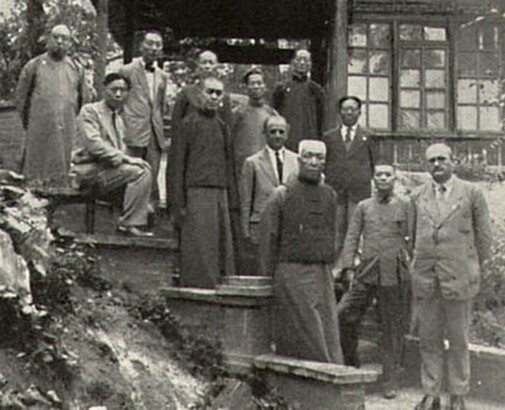
Andrija Štampar (on the right) in Lanchow, China, in 1930s, establishing public health service there.
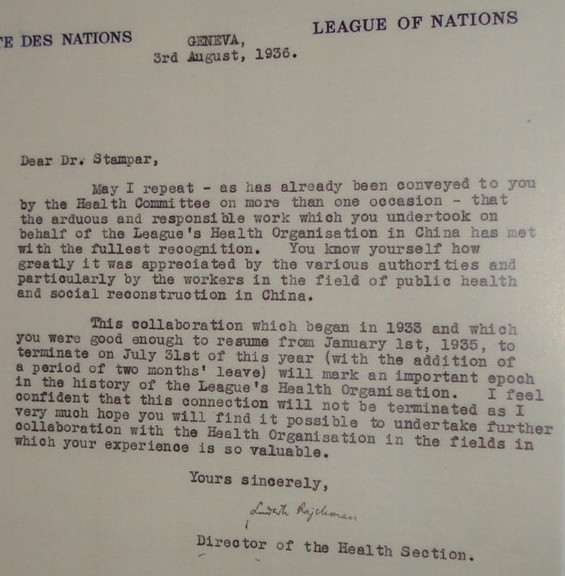
A letter of recognition sent by the League of Nations to Andrija Stampar in 1936 for his successful work on public health and social reconstruction in China.
The above three are a part of an exhibition devoted to Andrija Štampar, organized by the Croatian State Archives from July 8th to September 9th 2008. The author of the exhibition is Melina Lučić. It is accompanied by a booklet Andrija Štampar (40 pp) issued by the Croatian State Archives.
- Andrija Stampar is the father of the World Health Organization (WHO)
- Andrija Štampar: Travel Diary 1931-1938, (edited by Željko Dugec and Marko Pećina), Zagreb 2020.
Berislav Borčić
(1891-1977), was distinguished Croatian expert in social medicine. In
the period of 1930-1938 he served as the chief advisor for the Chinese
Ministry of Public Health. In Nanking (at that time a capital city of
China), he organized the Central Hygiene Institute with the School of Public Health, modeled on the one already existing in Zagreb, the School for midwives and assistants and the Central State Hospital.
In 1946, at the invitation of the UN Relief and Rehabilitation
Administration (UNRRA), he directed the mission of health promotion and
organisation of medical care in China, and in 1947 he founded and led
the World Health Organization
(WHO) mission in China. He was the WHO’s chief health consultant at the
International Children’s Fund UN (UNICEF) in Paris (1948-50) and New
York (1950-55), and in the period of 1955-57 he served as a deputy
general director of UNICEF in New York.
Lit. Berislav Borčić, Hrvatski biografski leksikon
Berislav Borčić (1891-1977), born in Rijeka, was a specialist in medicine and veterinary studies. As a representative of the League of Nations he was sent China (1930-1938). Among other things, he suggested founding the Central Hygene Institute and the City Hospital in Nanking. Information from Croatian Encyclopaedia.
Borčić visited China again in 1945 and 1947 as a representative of UNRRA, UNICEF and WHO missions.
Borčić was entrusted the overall responsability for coordinating the public health programme in China. Andrija Štampar, who came to China later than Boričić, assisted Chinese provinces in the organization of Health Services in rural areas. For more informaton, see
- Branko Cvjetanović: Cooperation Between Chinese and Croatian Public Health Workers, Zagreb 1998 (Visions and achievements of B. Borčić, C. C. CHen, A. Štampar, and Y. C. Yen in Puublic Helath during socio-economic and political changes in China in turbulent years of the third decade of the twentieth century). The booklet has 22 pp, and its content was presented by the author on May 20th 1998 at eh "Andrija Štampar" School of Public Health in Zagreb, Croatia, at the meeting of the Society of Croatian-Chinese Friendship.
- Andrija Štampar: Travel Diary 1931-1938 [PDF], Zagreb 2020 (39 pp), edited by Željko Dugac and Marko Pećina.
- Željko Dugac: Public Health experiences from interwar Croatia (Yugoslavia) and making western medicine in the 1930s China [PDF], Acta Med Hist Adriat 2018; 16(1);75-106
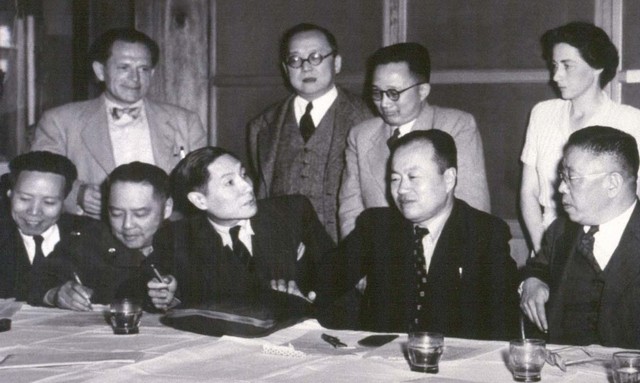
Berislav Borčić (standing
on the left) in Chunking, China.
ABMAC
China Committee, Chungking. Back Row, from left: Dr. Berislav Borcic,
Dr. James K. Shen (Shen Ko-fei), Dr. C. K. Chu, Mrs. Eleanor Brown, Dr.
Hsu Su-en. Front row, from left: Dr. Sah
Pen-tung,
Lt. Gen. Robert K. S. Lim, Dr. Han Li-wu, Dr. P. Z. King (Chin
Pao-Shan),
Dr. J. Heng Liu. Photo from ABMAC.
A quotation from the monograph by Randla M. Packard, The Making of a Tropical Disease, A Short History of Malaria,The John Hopkins University Press, 2007:
...Reichmann enlisted two fellow Europeans, Croatian Berislav Borčić and Andrija Štampar, who had both been on the faculty of the Zagreb School of Public Health, to develop a Rural Rehabilitation Program in the Kiangsi province in China. The program, bugun in 1930, combined social and economic development efforts with improvement in health services, including malaria control. Reflecting on his experience directing the program, Štampar wrote that "After working nearly three years in China, I am especially impressed by one fact. Successful health work is not possible where the standard of living falls below the level tolerable existence. Public health policy must be intimately connected with a programme of general social improvement." (p. 135)
We mention by the way that there is also another Croatian medical expert bearing the same name - Berislav Borčić (1932-2004), an epidemiologist of world renown.
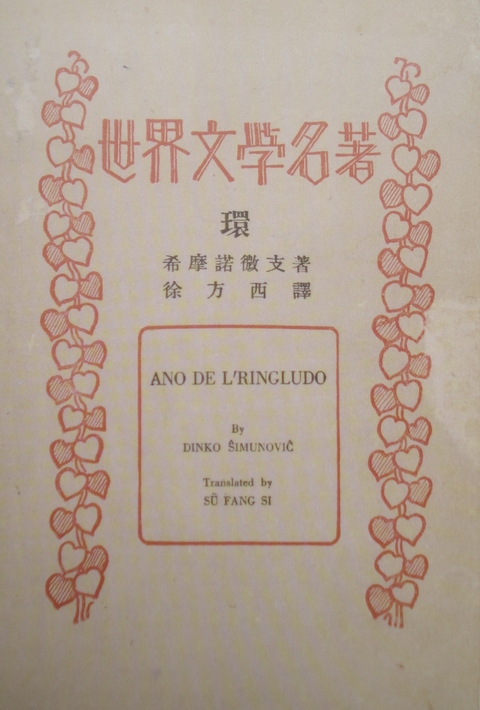
Dinko Šimunović (1873-1933): Alkar (Alka knight), Chinese edition in 1936.
(Retranslated into Chinese from its Esperanto edition, translated from Croatian original by Franjo Janjić.
Many thanks to Spomenka Štimec of the Esperanto Croatian-League in Zagreb for this information.)
Dinko Šimunović was distinguished Croatian writer.
Source o f the photo: Blago Nacionalne i sveučilišne knjižnice u Zagrebu, 2007., p. 67.
Charles Billich is outstanding Croatian painter born in Lovran in Istria, and since 1956 working in Australia. He is Honorary Citizen of Atlanta, Centennial Olympic City, USA, since 1996. Billich was the official artist of the Australian Formula 1 Grand Prix Melbourne in 1996. In 1997 he was designated the official artist of the Australian and French Olympic teams for Olympic Games in Sydney in 2000.

Charles
Billich
Bing
Mah Yong Show
at
American
Sports Art Museum
- Australian Olympic Committee Headquarters, Sydney
- International Olympic Museum, Lausanne, Switzerland
- Selengor Turf Club Equestrian and Sports Center, Kuala Lumpur, Malaysia
- United States Sports Academy
- QinShiHuang BingMa Yong Museum, X'ian, China
Source: Croatian Sports
Charles Billich's
Bing Ma Yong Terra Cotta Warrirors
Charles Billich is
Croatian-Australian painter, born in
Croatia,
and official painter of the 2008 Olympiad in China
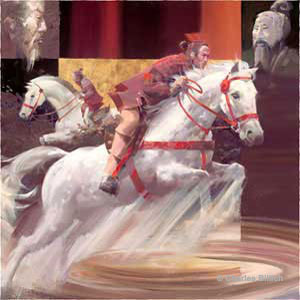 |
 |
 |
 |
 |
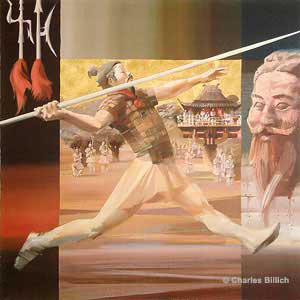 |
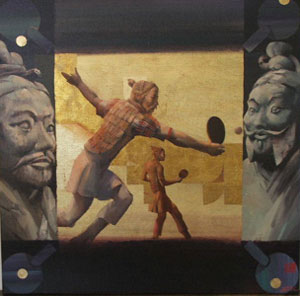 |
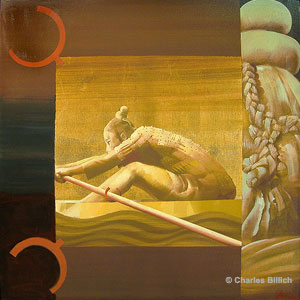 |
 |
 |
 |
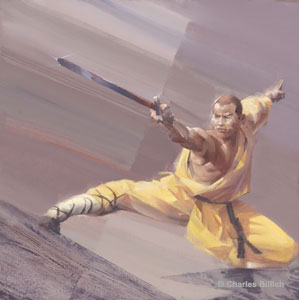 |
Source: www.billichgallery.com
|
Inspired by the conviction that the Chinese Olympic Committee should adopt a traditional symbol as the official image of the 2008 Beijing Bid, Billich created the Bing Ma Yong cycle of paintings. Best known as the Terra Cotta Warriors of X'ian, Shaanxi Province, Billich has brought an ancient Chinese icon to life through images contrasting 21st century Olympic sports and 384 BC Qin Dynasty magnificence to the glory of both. So well received has this work been that Billich's Bing ma Yong images are represented on a collection of 16 postage stamps currently in circulation in China. Source: www.billichgallery.com See Charles Billich's series on Croatian Art and Croatian Inventors. |
More information about Charles Billich in China
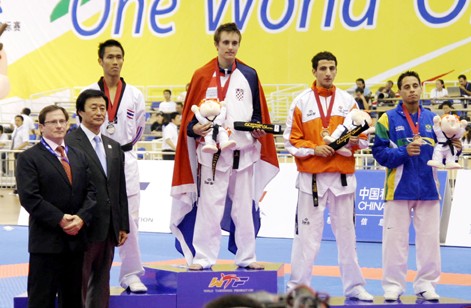
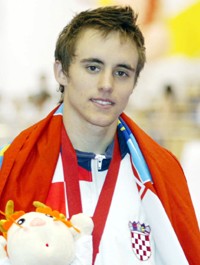
Filip Grgic won gold medal at the 2007 Bejing WTF World Taekwondo Championships in male bantamweight (under 62kg) category, China. Photo from www.wtf.org.
And Tamara Boros was the best ping-pong player in the world among women of non-Chinese origin for 1998 and 1999 (ranked 13th, the first 12 places being occupied by Chinese players, as well as many places after Tamara). She is famous for her attractive offensive style.

She was the winner of the 2002 TOP 12 European ping-pong competition in Rotterdam. After this success she was placed second (!) on the world rank. She won the third place at the World Championship in Paris in 2003, which is the greatest success of Croatian (and European!) table tennis for women.

![]()
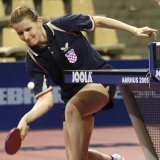
She also won the 2006 Europe TOP 12 competition in Copenhagen.

Tamara is the only one in Europe capable to cope with ping-pong players from Asia (China, Japan, etc.). In 2006 she has been invited to China to play table tennis in their professional league, which is the strongest one in the world.
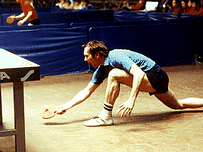
Among the most outstanding Croatian sportsmen was Dragutin Surbek (table tennis), who had won hundreds of tournaments, from Tokyo and Beijing to Zagreb (37 medals from european and world championships!). In China he is known under the nickname Surbeka, treated as table tennis God there, and in Croatia as Surba.
Dragutin Surbek is the only non-Chinese table tennis player in the world who has more wins than defeats in matches with Chinese players.
The famed scientist (biologist) and table tennis player, Professor Zarko Dolinar, who captured eight gold medals at world championship competitions. Dr. Dolinar still holds an unusual world record. He is the only athlete in the world who was a world champion as well as a doctor of science. He was former World Doubles Champion and had a prestigious position of ITTF (International Table Tennis Federation) Sports Science Committee head. It is interesting that he taught John Lennon to play table tennis (information by Nenad Bach). In China he was invited to have dinner with president Mao Tse Tung, together with R. Nixon, president of the USA (information by Nenad Bach).
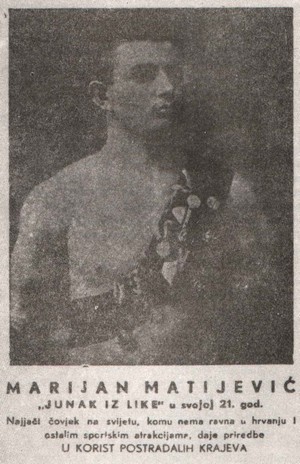
Marijan
Matijevic in 1899, at the age of 21.
Many thanks to Andreja Malovoz, Zupanja, for her kind help.
Outstanding Croatian wrestler ("Junak iz Like" - Hero from Lika) was Marijan Matijevic (1878-1951). Matijevic traveled throughout the world to exhibit his extraordinary physical power (bending metal rods, stone breaking), including China and Japan. He is known to have surpassed Primo Carnera from Italy. Buried in the town of Zupanja near Danube. He is known for his numerous humanitarian public performances. Matijevic was enormously popular, which can be seen from thousands of articles published throughout the world in English, German, French, Italian, Spanish, Arabian, Turkish, Chinese, Japanese and other languages. Once in the USA, when he was once introduced as an "Austrian athlete", he hastened to correct the announcer: "Dear gentlemen, I am not Austrian, I am Croatian born in proud Lika...".
Source: Croatian Sports


Josip Mikulec, a famous Croatian adventurer and hiker, travelled the whole world in the course of 28 years. He visited also China. Mikulec collected more than 30,000 autographs of world-famous people.
On the left page on the top: Chen Zize (this is a name), and some other names, relatedto the leaders of revolution. On the right-hand side: how to work with people, Repulic of China, sixth year, July (i.e. in 1917). Many thanks to Ms Wang Mu from the Croatian program of Chinese Radio International for her kind help.
For more information see
Joseph Mikulec Croatian globetrotter appearing in a silent movie 1922
A famous Chinese gymnastics champion Li Ning, who carried the Olympic flame during the opening ceremony of 2008 Bejing Olympics, started his spectacular international career in Zagreb, Croatia, at the age of 17. Recruited at 17 by the national team, Li snatched six gold medals at the Zagreb World Cup in October 1982. Source.
Dolls
The King of Dolls, a famous Croatian collector of dolls representing various countries and cultures throughout the world, received upon his request a doll from Mao Tse Tung, president of China, in 1966. The doll is kept in the Ethnographic Museum in Zagreb, Croatia, among more than 300 other dolls.
Ivana Brlic Mazuranic (1874-1938) is a very well known name among Croatian children. She wrote beautiful books of Croatian fairy tales, the most famous being Price iz davnine (Tales of Long Ago) that appeared in Zagreb in 1916. It was translated from Croatian into English by F.S. Copeland under the title:
|
Croatian Tales of
Long Ago
by Iv. Berlic Mazuranic |
and published in 1924. in London by George Alen & Unwin Ltd (260 pp, hardcover). These stories have become popular worldwide due to recent fantastic flash-art presentations, initiated by Helena Bulaja, Zagreb. See for example Neva, music and animation by Ed Beals. Books of Ivana Brlic Mazuranic were translated into all major world languages (more information in Croatian). Except in English, there exist also translations into
- Swedish (Stockholm, 1928)
- Danish (Kopenhagen, 1929/30)
- Czech (Prague, 1930)
- Russian (Zagreb [!], Skazki davnyago vremeni, 1930)
- Slovakian (T. sv. Martin, 1931)
- German (Salzburg, 1933)
- ...
- Chinese (1957)
Source: Croatian Art
Croatian
Tales of Long Ago by Ivana
Brlić Mažuranić,
translated from Croatian into English in 1924, and then from English into Chinese in 1957.
Many thanks to Mrs. Spomenka Štimec for this information
(of the Esperanto Croatian-League in Zagreb).
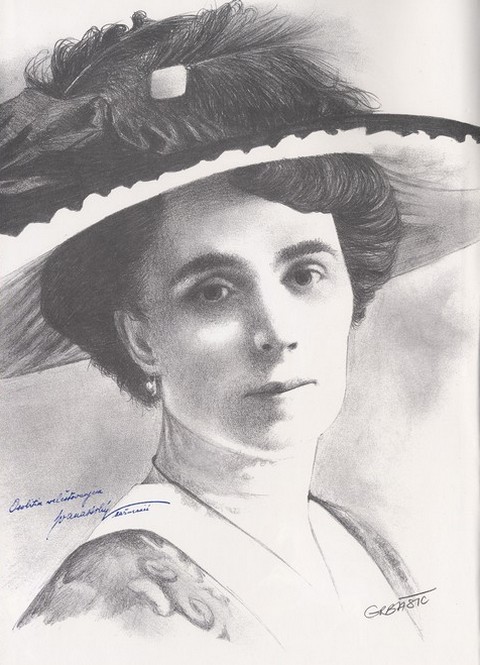
Ivana Brlić Mažuranić (1874-1938), Croatian writer for children
Apprentice
Hlapić by Ivana Brlić
Mažuranić,
translated from Croatian into Chinese in 1983.
For a more detailed information about various translations throughout the world of books for children by Ivana Brlić Mažuranić see Villa Ruzic in Rijeka and Croatian Tales of Long Ago.
Many thanks to Mr. Theodor de Canziani Ružić for permission to publish the photos of books from the library of Villa Ruzic in Rijeka, Croatia.
Miro Gavran's novel How We Broke Our Legs is published in Beijing, PR of China by World Affairs Press. The translation into Chinese has been done by Kewein Yan. The prefaces to the novel have been written by Chen Haosu and Ante Simonić. To date, this novel has come out in five editions in Croatian.
Science

Vilim Feller as a student at
the University of Zagreb
with kind permission of prof. Marta Zdenkovic, Zagreb
William Feller (Zagreb, July 7th, 1906 - New York, January 14th, 1970), outstanding Croatian - American mathematician, born in Croatia as Vilibald Srecko Feller. As a student he changed the name to Vilim. Graduated in mathematics from the University of Zagreb (1925), earned his PhD in Göttingen (1926) under Richard Courant. He prepared a part of his thesis already as a student in Zagreb. Professor in Kiel (Germany, 1928-1933), Copenhagen (Denmark, 1933-1934), Stockholm, and Lund (Sweden, 1934-1939). In 1938 he married Clara Nielsen. Since 1939 lived in the USA, employed at Universities of Brown, Cornell, and since 1950 at Princeton University as a Eugen Higgins Professor of mathematics. Feller wrote the review of A.N. Kolmogorov's famous book Grundbegriffe der Wahrscheinlichkeitsrechnung for Zentralblatt für Mathematik in 1934. One of initiators of editing Mathematical Reviews (1939), and one of its first executive directors (1944-1945). One of the founders of Probability Theory as a scientific discipline, best known for his two volume monograph An Introduction to Probability Theory and Its Applications, which is considered as one of the finest mathematical textbooks of the 20th century. It was translated into Russian (with foreword to Volume 1 written by Kolmogorov), Chinese, Spanish, Polish, and Hungarian. About hundred and fifty mathematical notions bear his name: Feller process, Feller transition function, Feller semigroup, Feller's property, Feller Brownian motions, Feller's test for explosions, Lindeberg-Feller condition, Feller operator, Feller potential, Feller measures, indefinite Krein-Feller differential operators, Kolmogorov-Feller equation, etc. At the International Congress of Mathematicians held in 1958 in Edinburgh, Feller delivered a plenary talk "Some new connections between probability and classical analysis." In 1966 he was elected to the international scientific committee which had to choose candidates for the 1966 Fields Medal at the International Congress of Mathematicians in Moscow. Feller had 17 PhD students. Member of several national academies: former Yugoslav (now Croatian) Academy of Sciences and Arts in Zagreb, Royal Danish Academy of Sciences, National Academy of Sciences, USA, American Academy of Arts and Sciences, Boston, and of prestigeous scientific organizations: Royal Statistical Society, London, and The London Mathematical Society (honorary member). Recipient of the 1969 National Medal of Science by the president of the USA (posthumously in 1970). An asteroid was named after him in 1996: 21276 Feller (1996 TF5).
Chinese edition
Feller, William K'ai-lü-lun chi ch'i yin-yung. Ts'e I. (Chinese) [Probability theory and its applications. Vol. I] Translated from the English by Hu Ti-ho and Lin Hsiang-ching Science Press, Peking 1964. xii+253 pp.

William Feller
(in Chinese, from the 1964 Chinese edition of Volume 1)
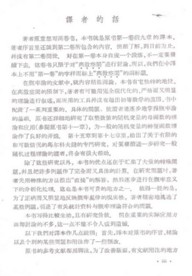 |
|
 |
Many thanks to Professors Sibe and Pavao Mardesic for the above pages of Feller's book in Chinese, 1964, kept in the Library of the School of Mathematical Sciences in Beijing. The 1964 edition has been printed in 9,600 copies, and subsequent Chinese editions seem to exist:
Photo from Book.ChinaUnix.net
The second volume of Feller's monograph has been issued in Chinese in 2007:
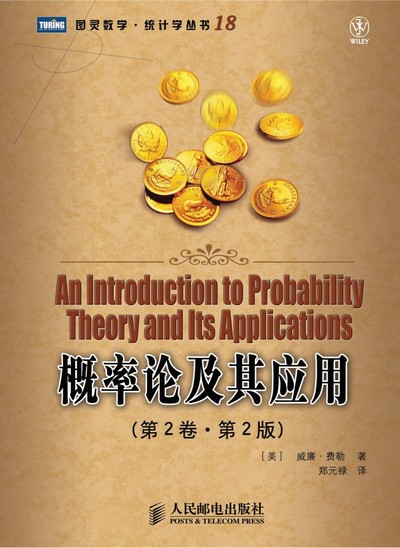
William Feller: An Introduction to Probability Theory and Its Applications, Volume 2, Chinese edition, 612 pp, ISBN 978-7-115-16735-4, source www.turingbook.com
Source: William Feller
One of our best theoretical physicists was Gaja Alaga (1924-1988), member of the Croatian Nobility from Backa and Bunjevci Croat.

Professor Gaja Alaga on the left, a member of Croatian Nobility. Source www.knjiznica.phy.hr
He worked not only in Zagreb, but also at the Niels Bohr Institute in Copenhagen, Berkeley, Ludwig-Maximilians University in Munich etc. In 1955, in cooperation with K. Alder from Switzerland, A. Bohr from Denmark and B. Mottelson from the USA, he discovered the so called K-selection rules and intensity rules for beta and gamma transitions in deformed nuclei.
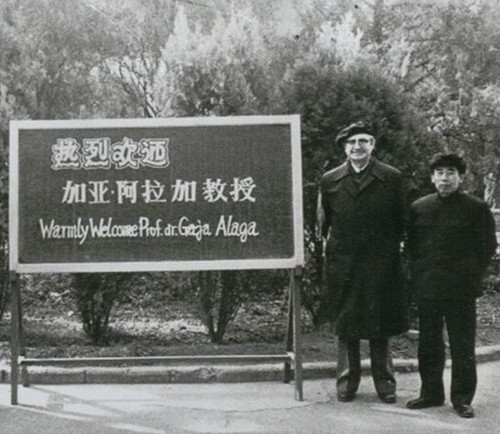
Warm reception of professor Gaja Alaga in China. Source www.knjiznica.phy.hr
Around 1740 Franz or Franz-Luka Jelacic, born in 1720 in Vienna, died in Moscow after 1776. He demanaged to St. Petersburg in Russia, where he studied medicine and earned his diploma in 1743. As an expert in medicine he participated in three expeditions in China (1747, 1754-1756 et 1757-1764). In 1756 this Croat was the principal surgeon in the Moscow hospital, and in 1764 he worked as a surgeon in St. Petersburg.
Source: Jelacic's in Russia (written in French), by Michelle Iellatchitch, France, translated from French by D.Ž.
THE RUSSIAN BRANCH OF OUR
JELACIC'S
Written by STJEPAN RADIC
Hrvatsko Kolo, Zagreb, 1909, p. 278-304.
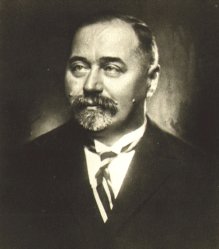
The name of this Jelacic was Franjo Luka, and he was educated at Viennese Jesuits, from where he escaped to Russia. One of his descendants, Franjo Josipovic Jelacic, was a famous surgeon (1808-1888) and as a university professor of Kazan has a great merit for founding the Kazan clinic, as we learn from the same encyclopedia.
As soon as this Franjo Jelacic married with a Pravoslav Russian, he accepted pravoslav faith (according to the laws of the time), and until that time our Jelacic's were Catholics. The son of Franjo - Aleksandar Francevic Jelacic, was a famous lawyer and the head of exceptionally respected and educated family of Russian Jelacic's. He had five grown up sons, and two of them were distinguished with their literary and educational work.
Russian Jelacic's preserved their Croatian traditions, and they are especially proud of their famous ban [viceroy] Jelacic. They sojourned already in Opatija, and also visited Zagreb, and of course, the Jelacic monument [on the Zagreb main square] in the first place. Aleksandar Jelacic is a liberal of English character, as was the case with almost all Russian thinkers in the 60s of the last [19th] century. Their sons belong to different political camps, but all of them are very important and extraordinarily educated people.
...
Source: Stjepan Radic,
translated
from Croatian by D.Ž.
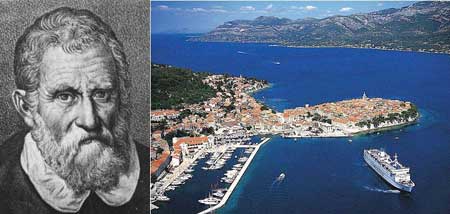
SUMMARY
ETNIC ORIGIN OF THE EXPLORERS POLs (alias POLO-s)
Andjelko Nedo
Paveškovic, Montecarlo
(Unfortunately only summary of this excellent work is available in
English.)
Can the explorers POL-s (alias Polo and Pollo) be called "The Venetian Polos"?
- contrary to the Venetian documents, which say that they "came from Dalmatia", a Croatian maritime province. CHRONICON IUSTINIANI, 1358 (annotation) in the Venetian Bibliotheca Marciana. The Venetian manuscripts from: 1423., 1446., 1450/60., and the two documnets from the beginning of the 1600-ies.
The Venetian chronicler Marino Sanudo junior writes to that effect in 1522.: "Poli di Dalmatia". See A. C. Moule: MARCO POLO, THE DESCRIPTION OF THE WORLD (London, 1938), 17, 19, 20.
A. C. Moule says: "None of the large number of Venetian genealogies which we have been able to consult seems explicitly to recognize more than one family of Polo, namely "Polo di Dalmatia". Moule, 20.
Giovanni Orlandini, the Venetian authority on our subject writes in 1926., that the genealogy of the Polos is not "chiara" (clear). He asserts that their generalogy is traceable in Venice as from the middle of the XIIIth century. He believes that the Polos had been gradually comming from the Near East ports and settling, after the year 1261., in Venice in the consequence of the downfall of the Near East latin Empire. See G. Orlandini "Marco Polo e la sua familia" in ARHIVIO VENETO TRIDENTINO, vol. IX. 1926., 1-68, especiall pp.: 1-3.
A. C. Moule contends that the Pols genealogy can be traced in Venice, starting from the middle of the XIVth century. Moule, 20.
Marco Polo the elder writes in his Last Will (Venice, 1280.) that he came from Constantinople. As quoted by moule, 523-524.
His brothers, the merchant-travellers Maffeu and Nicolau fetched in 1250. the merchandise from Venice to Constantinople. They sejourned in the Black Sea area from then untill the year 1261. In 1261. They went to Asia and came back in 1269. In 1271., they went from Venice to Asia. Marc Pol the junior the son of Nicolau, (the author of the book), accompanied them on their second journey. (He was born in 1254., and died in 1324.).
They returned from Asia in 1295. Then they (definately) settled in Venice.
According to Vladimir DePolo, some Croatian manuscripts do mention: "The merchants, shipbuilders, travelers,... (etc) POLOS from Dalmatia, in the Near East ports including Constantinople. (The research paper published in Zagreb 1996. in the collection of the research works, entitled: MARKO POLO and THE EASTERN ADRIATIC IN THE XIIITH CENTURY).
Conclusion
By their family roots comming from Croatia, the explorers Pols settled
in Venice, after they had accomplished their historic explorations.
Therefore they are misidentified as the "Venetian Polos".
(One Marco Polo was in the year 1300., among the rebels against the Venetian authorities, who condemned them to exile and then to death. Then the rebels flew to Croatia. Some writers believe that the said Marco Polo-rebel, was is fact the explorer Marc Pol himself.).
Andelko (Nedo)
Paveškovic: Putopisac Marko Polo,
POLJICA, br. 23, 38-66, Split 1998.
Source: www.ikorcula.net/marcopolo
A 14th century document linking Marco Polo with Dalmatia

A copy of the 14th century British Museum Additional MS 12475 linking Marco Polo with Dalmatia. Line against shield with 4 birds "(P)olo, questi veneron orrigamente de dalmatia". Polo, this man originally came from Dalmatia.
Document is presented to the Marco Polo Centre Korcula - Croatia on Sept. 7th 1998 by James A. Gilman on behalf of Europa-Youth.
Source: www.ikorcula.net/marcopolo
Marko Polo - turistički simbol Korcule
Najveći putnik svih vremena, Marko Polo rodio se, prema mnogim ozbiljnim izvorima (ukljucujuci i Enciclopediu Britannicu – najnovije izdanje iz 2003. g.), u Korčuli 8. sijecnja 1254. godine.
Kao dječak od 17 godina otišao je sa svojim ocem Nikolom i stricem Matom, poznatim trgovcima, na veliko putovanje po Putu svile stigavši do dvora moćnoga mongolskoga vladara Kublai Khana. Svojim izgledom i inteligencijom zadivio je tadašnjega najmoćnijega vladara na svijetu i on ga je primio u mongolsku diplomatsku službu u kojoj je postigao zavidne rezultate. Polovi su se vratili u Europu 1295. godine i živjeli su u Veneciji gdje su se i dalje bavili trgovinom iako su se već obogatili na svom dugogodišnjem putovanju po Dalekom Istoku.
Marko Polo 7. rujna 1298. g. kao zapovjednik mletačke galije, sudjeluje u najvećoj pomorskoj bitki Srednjega vijeka, onoj između Venecije i Genove, koja se zbila pred Korčulom. U tom okrutnom pomorskom boju 7000 Mlečana je poginulo, a 7400 zarobljeno, čime je Venecija doživjela poraz od kojega će se dugo oporavljati. Među zarobljenicima bio je i Korčulanin Marko Polo, koji je, nakon četiri dana u korčulanskoj tamnici, proveo godinu dana u đenovskom zarobljeništvu. Tamo je diktirao svoje pustolovine i doživljaje u Kini svome zatvorskom sudrugu, Rustichianu da Pisi na francuskom provansalskom jeziku. Tako je nastala poznata putopisna knjiga pod naslovom "Čuda svijeta", koja je tiskana na pergamentu u nekoliko desetaka primjeraka jer tada u Europi još nije bio izumljen papir.
Ta Polova knjiga otkrila je tada zaostaloj Europi jednu razvijenu i mo'nu kinesku civilizaciju, a mnoga Markova zapažanja o stvarima i pojavama u Kini doimala su se kao razigrana mašta talentiranoga pisca. On je u noj, izmedu ostaloga, govorio o gradu Kinsai s 10000 mostova i grijanim ulicama s bajkovitim pala;ama i vrtovima, o sustavu pošta konjskom zapregom koja je izuzetno djelotvorno funkcionirala, o papirnatom novcu, o nafti kao izvoru energije, o ;udotvornim ljekovitim travama, o bogatim tkaninama svih vrsta, boja i desena, nalazištima zlata i dijamanata, mirodijama, neobi;nim životinjama, tehnikama ratovanja i vladanja, suzbijanju inflacije i krivotvorenja pomo'u neizbrisivoga kraljevskoga žiga – o stvarima o kojima Europa nije mogla ni sanjati.
Markova knjiga, "Čuda svijeta", čitala se na kraljevskim dvorovima i u plemičkim palačama s velikim užitkom i zanimanjem, a danas se smatra najvećim putopisom u svjetskoj književnosti. Na talijanskom je dobila naslov Il millione (Milijun), vjerojatno zbog velikih brojki kojima je Marko opisivao svoje doživljaje, a na engleskom The Travels of Marco Polo (Putovanja Marka Pola). Ona je poslužila i kao predložak za brojne moderne romane (Colerus, Jennings, Sharp, Griffiths) igrokaze, opere, filmove i mjuzikle (Duka).
Na samrtnoj postelji
Marka Pola pitali se njegovi prijatelji
zbog čega je napisao i ispričao toliko neistina, a on im je kratko
odgovorio:
"Nisam napisao ni pola od onoga što sam vidio i doživio jer
sam
znao da mi nećete vjerovati."
Marko Polo postao je legenda Korčule i njezin najprepoznatljiviji
image. O njemu, kao Korčulaninu, pišu brojne revije i
novine,
snimaju se dokumentarni filmovi (film "Povijesna bitka Marka Pola" u
režiji Balda Čupića dobio je prvu nagradu na festivalu svjetskih
dokumentarnih filmova u New Yorku 2001. godine).
Turistička zajednica Grada Korčule osnovala je TMedunarodni centar Marko Polo za istraživanje i promicanje života i djela toga prvoga turiste i čovjeka koji je bio daleko ispred svoga vremena i koji je živio najzanimljivijim mogućim životom.
Kuća Marka Pola
Source: www.ikorcula.net/marcopolo
Source for the entire collection above: www.ikorcula.net/marcopolo
Presentation of the Veliki Tabor Castle on the north of Croatia in Chinese language:
Click by mouse to get a larger photo.
The above translation from Croatian into Chinese was made by Mrs. Lü Ke Feng, Associate Professor, lector of Chinese language at the Faculty of Arts and Letters of the University of Zagreb, and her name can be seen in the last line of the above translation. She also visited the Castle, and had a friendly talk with Mr. Josip Štimac, in which Professor Vladimir Ćepulić was interpreter. Mrs. Lü Ke Feng is Associate Professor at the International Pedagogical Faculty of the Zhejiang University in Hangzhou, P.R. China.
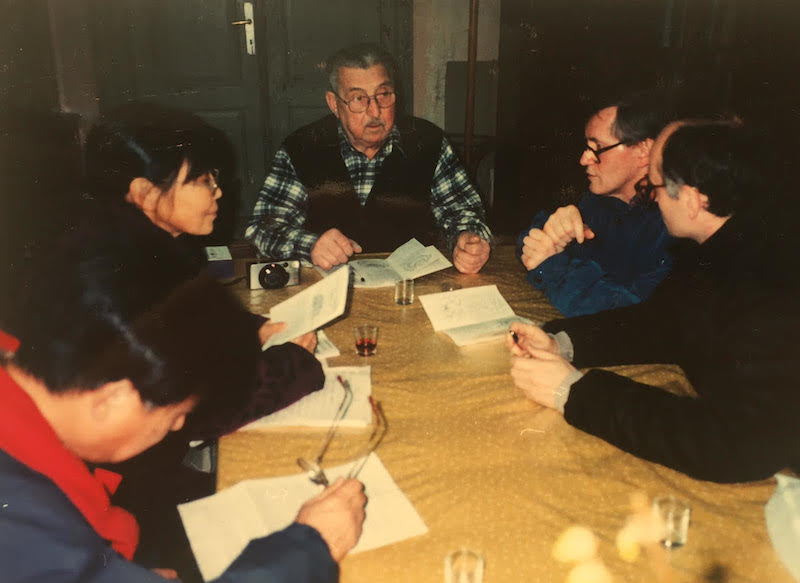 In Veliki Tabor in 2000: on the left of Mr. Josip Štimac is Mrs Lü Ke Feng with her husband,
In Veliki Tabor in 2000: on the left of Mr. Josip Štimac is Mrs Lü Ke Feng with her husband, and on the right Professor Vladimir Ćepulić with D.Ž.
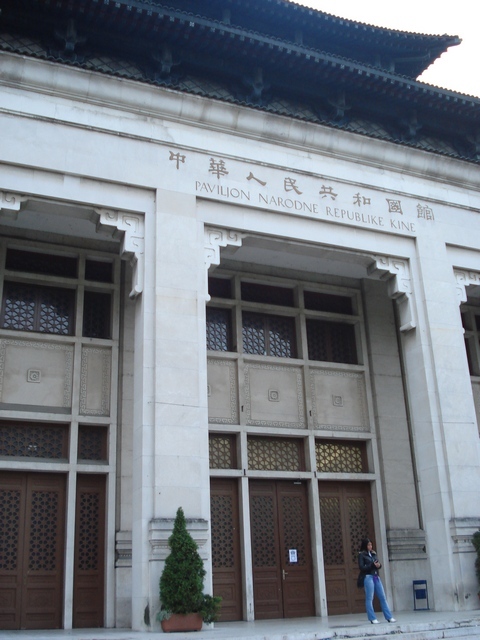

Pavillion of the P.R. of China at the Zagreb Fair

Jelko Yuresha and his wife Belinda Wright Yuresha, classical ballet dancers, danced in Beijing, China.
Jelko Yuresha was born as Željko Jureša in Croatia's capital Zagreb.
Source Davor Schopf and Mladen Mordej Vučković: Yuresha - Visions and Dreams / Jureša - Vizije i snovi,
(in English and Croatian), Zagreb 2011
Aleksa Benigar (Alexius Benigar, 1893-1988), born in Zagreb, was a Croatian missionary in China for 25 years, since 1929 till 1954. He is an author of an extensive monograph about blessed Alojzije Stepinac. His Chinese name was Pen Lin Gan, and he taught theology for three generations of Chinese students in Hankow, several hundred of them. He wrote extensive two volume work "Liturgia Romana", in Beijing in 1947. He also wrote an extensive work "Theologia spiritualis" in the Latin language, dedicated to blessed Alojzije Stepinac, published in Sapporo in Japan in 1958, reprinted in Rome in 1964). Father Benigar spoke seven languages: Croatian, Polish, Russian, German, Chinese Mandarin, Italian and Latin.
Chinese and Croatian postage stamps
Two very nice postage stamps have been issued by Croatian Post on the occasion of 15 years since establishing diplomatic relations between the China and Croatia (1992-2007). Both stamps have been designed by Boris Ljubicic, one of the best Croatian designers.

Source: Croatian Post
Here the name of Croatia is written in Chinese characters.
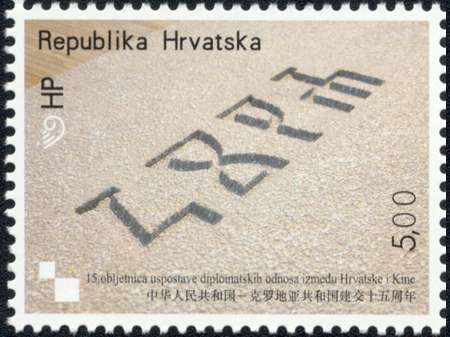
Source: Croatian Post
Here the name of China (Kina) is written in Croatian
Glagolitic characters.
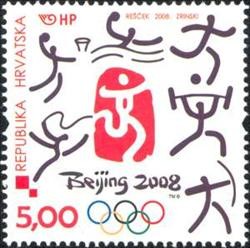
Coratian Post: Olympic Games, Beijing 2008

Nika,
a young Croatian fan from China,
collaborator of croatian.cri.cn,
with a hat bearing the inscription HRVATSKA
(Croatia),
and with colors of the Croatian
Coat of Arms
China Radio International (CRI) in Croatian langauge
Solemn reception in Zagreb
organized by CRI and the Croatian Embassy in Zagreb, on the occasion of
launching croatian.cri.cn
Croatian ballet dancer Jelko Yuresha
(Željko Jureša) sojourned with his wife Belinda Wright-Yureša in China,
where the y collaborated with the National Theatre in Beijing:
Jelko Yuresha Croatian ballet prodigy at the Royal Ballet in London since 1962
In 2004, the China International Culture Exchange Center (CICEC) in Beijing appointed Mr. Ante Glibota (1945-2020) Croatian historian of art and architecture, for a fiveyear term as Foreign Counselor for International Cultural Exchanges. Since 2010 he serves as Vice-President and Curator-in-Chief of the Museum of Art and Urbanity in Shanghai, China. He was appointed curator and editor of “Art and Sport”, an exhibition organized by Adidas and the International Olympic Committee for the Olympic Games 2008 in Beijing, China.
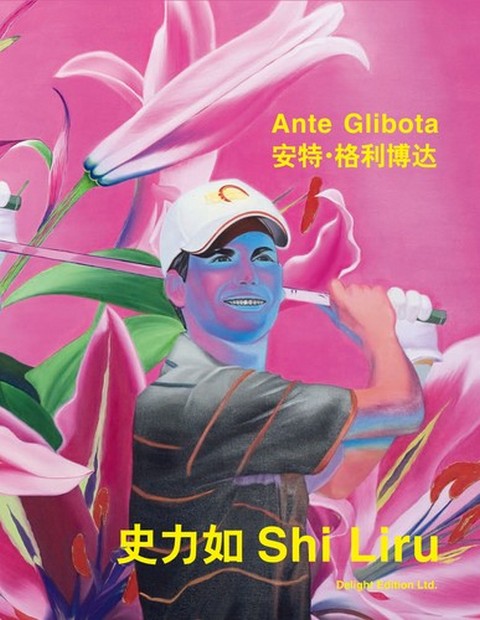
Ante Glibota, Croatian historian of art, wrote a monograph about young Chinese artist
Shi Liru,
published in China in 2012.
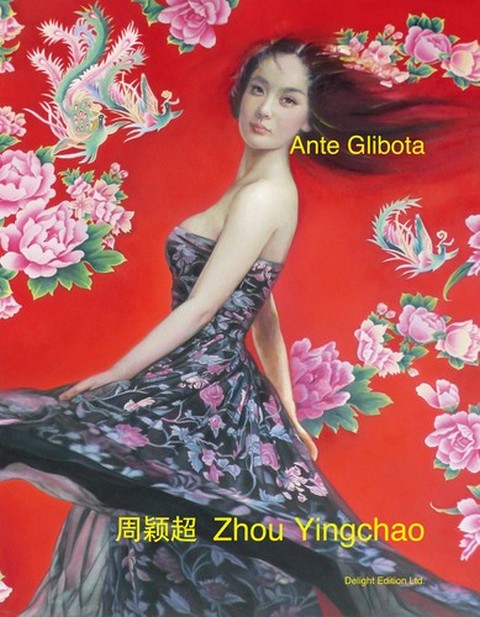
Ante Glibota: Zhou
Yingchao,
published in Bejing in 2011.
This is one of the most beautiful books that I ever had in my hands.
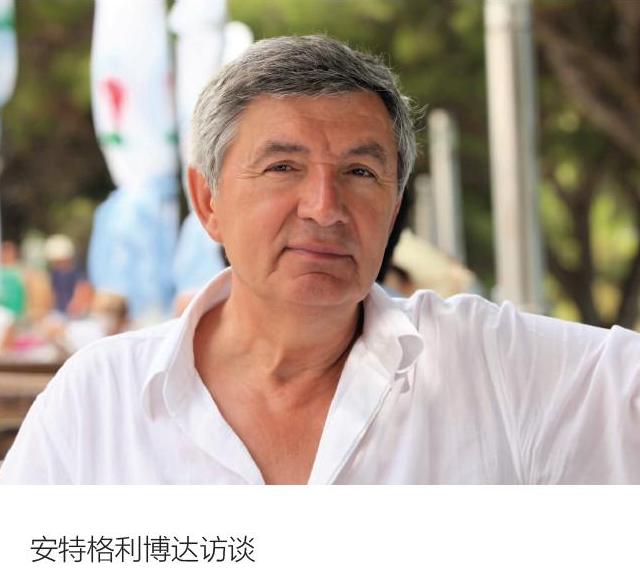
Author of the book, Mr. Ante Glibota (1945-2020)
Yin Yang fantastic Chinese painter exhibited in 2014 in Croatia due to indefatigable Ante Glibota
| |
|
Ante Glibota: NOMADISME IMAGINAIRE: L’ART DE VOYAGER EN BATISSANT L’HISTOIRE
The symposium “Phoenix International Art Forum” on “Trans-Contemporary: Indigenized Memory and Intercultural nomad”,
Location: Fenghuang, P.R. CHINA, September 23, 2017.
Organised by:
- Chinese Nationale Academy of Art, Beijing
- Art News of China
- Fenghuang Culture & Tourism Investment Co. Ltd
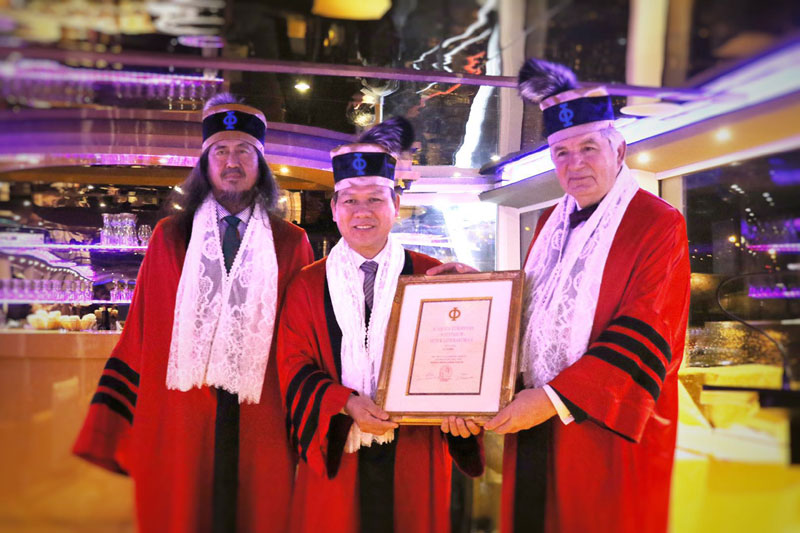
of a member of the Academy Europaea Institute, Paris, in 2019. Source CRI (Chinese Radio International).
Mr. Glibota was a vicepresident of the Academy. On the left Mr. Pi Zheng Qing, a member of the Academy.
Mr Glibota is the author of about 220 books and catalogues published in some 15 languages (more than hundred of them in China only).
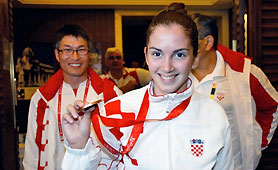
![]()
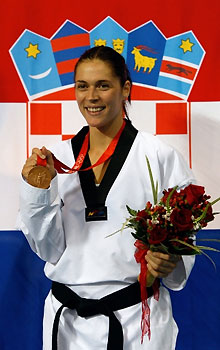
Martina Zubcic (feather category, under 57 kg, on the left) and Sandra Saric (under 67 kg) won bronze medals in taekwondo at the 2008 Bejing Olympic Games.
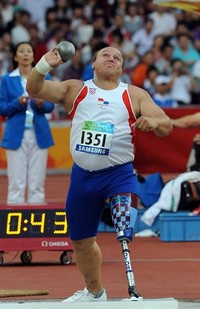 |
 |
Darko Kralj won gold medal at the 2008 Beijing Paraolympic Games in China. Competing in Men's Shot Put he broke a new world record at the National Stadium known as Bird's Nest. He said: "My biggest wish was to listen to the Croatian anthem in Beijing." Mr. Kralj lost his left leg during the Serbian aggression on Croatia. Photos by Xinhua.
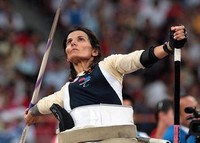 |
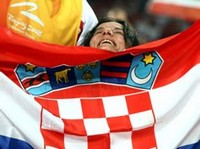 |
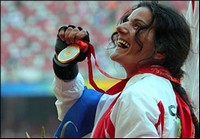 |
 |
Antonia Balek two gold medals for Croatia at the 2008 Paraolympic Games in China. The first gold medal has been won in women's javelin, and the second in women's Shot Put, both with new world records. The competition was held in the National Stadium known as Bird's Nest in front of 85,000 spectators. Antonia survived a deep coma which lasted for 3 years. Photos by Getty Images.
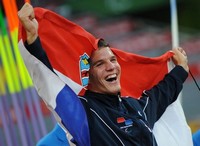 |
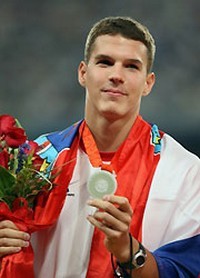 |
Branimir Budetic celebrates with his mother after finishing second during the final of the men's javelin F11-12 classification event at the 2008 Beijing Paralympic Games in Beijing on September 10, 2008. Photos by Getty Images.

Snjezana Pejcic won bronze medal at the 2008 Bejing Olympic Games in women's shooting (10m air rifle, 40 shots).
Filip Ude won silver medal in pommel horse at the 2008 Olympic Games in Beijing. It was the first gymnastics medal for Croatia on Olympic Games.
In 2008, at the Bejing Olympic Games, Blanka Vlasic had a great international success: she won silver medal. Before that she had as many as 34 consecutive wins at international competitions in the course of 14 months. Source: Croatian Sports
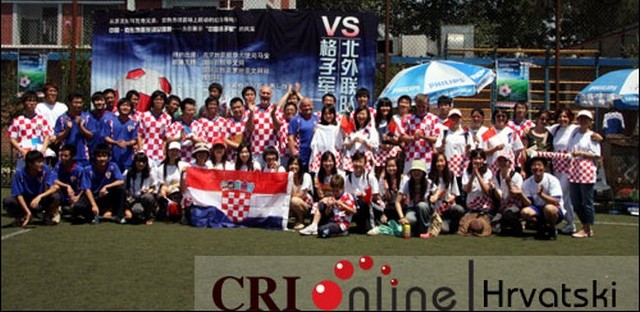
In 2009 Dr. Ante Simonić, ambassador of the Republic of Croatia, and Dr. Zlatko Mateša, head of the Croatian Olympic Committee, had the honor to be captains of two teams dressed in well known Croatian sports dresses. One team was composed of members of China Radio International Program in Croatian language, and another of former Chinese students of Croatian language in Bejing, plus Dr. Simonić and Dr. Mateša as captains.
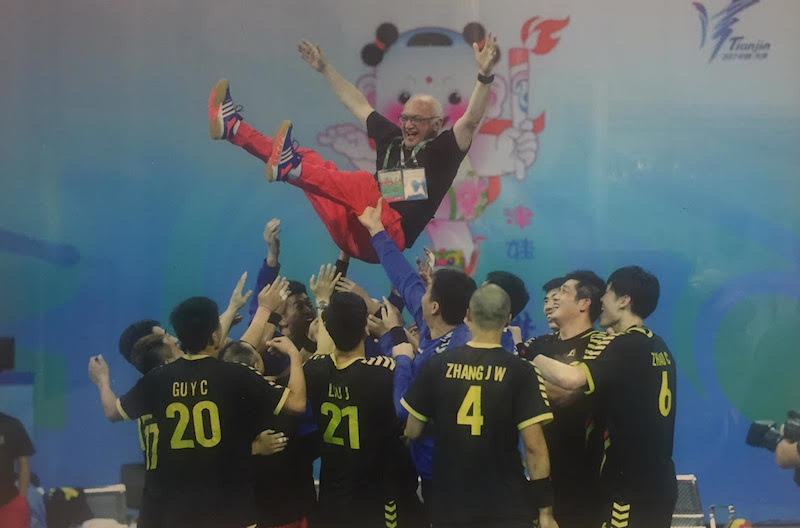
Nenad Zvonarek, handball trainer in China
Professor Nenad Zovnarek in his office at the University of Zagreb, with Professor Mario Cifrek
Nenad Zvonarek former selector of Chinese handball representation
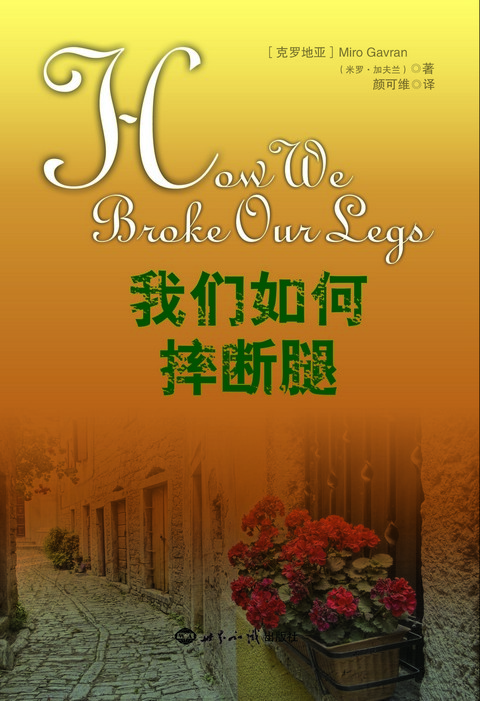
Miro Gavran: How we broke our legs, published in Chinese by World Affairs Press in 2009. The translation into Chinese has been done by Kewein Yan. The prefaces to the novel have been written by Chen Haosu and Ante Simonić.
Martina Filjak, distinguished Croatian pianist, with her fans in China, in front of the poster announcing her concert.
Maxim Mrvica, pianist, is playing Croatian Rhapsody, composed by Tonči Huljić.
There are numerous quite interesting interpretations throughtou the world, as well as by Chinese artists,
including some masters of Chinese zither. Listen to them!
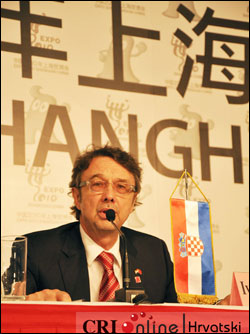
Ivica Maričić, one of the organizer of Croatian participation at EXPO 2010 in Shanghai. Photos by CRI.
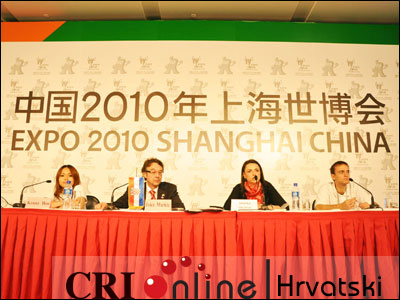
Peljesac bridge connecting Croatia with EU and China
Kineske izreke i priče - Chinese sayings and stories, translated from Chinese into Croatian by prof.dr. Vladimir Ćepulić, Zagreb

Professors Julijana Divković Pukšec and Vladimir Ćepulić,
Zagreb
2011
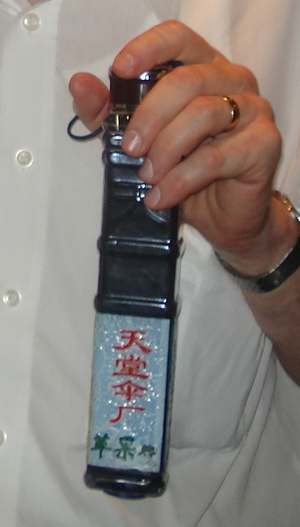
Professor Ćepulić with his Chinese umbrella
Vladimir Ćepulić, professor of Matheamtics, delivered a one semester course Chinese Language 1 at the Faculty of Electrical Egineering and Computing of the University of Zagreb in 2012.
ISBN: 978-953-6006-81-6
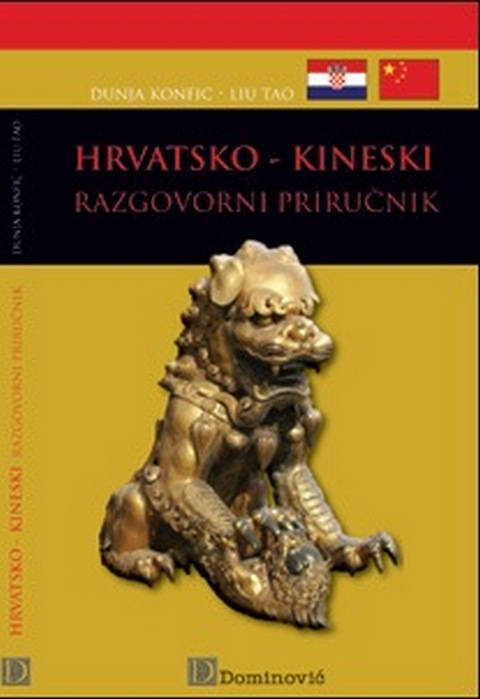
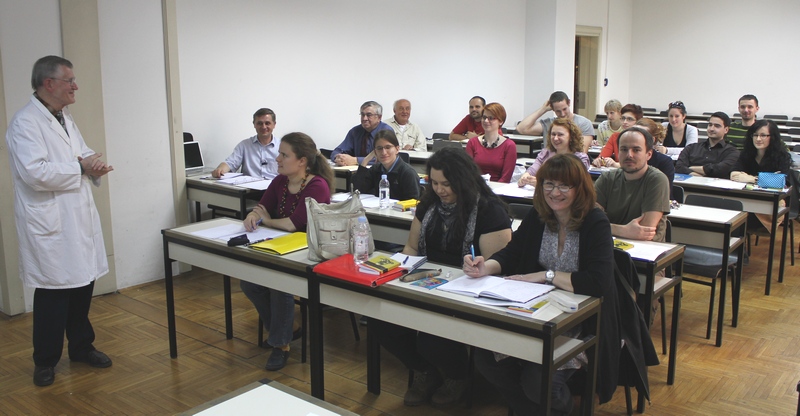
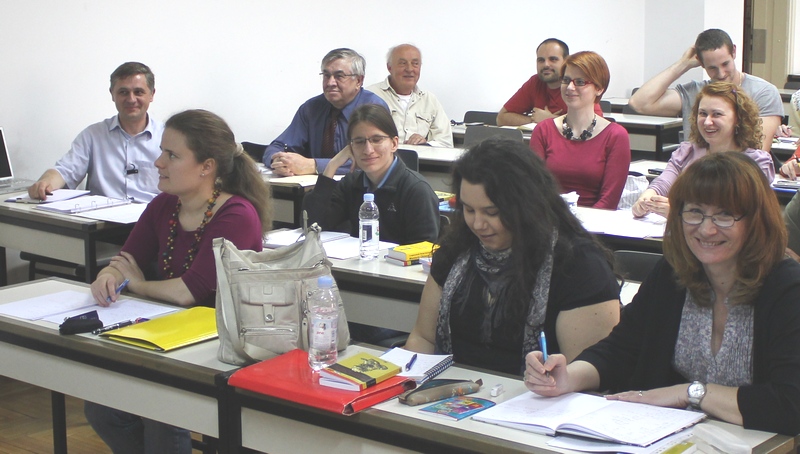
Attending the course: on the left prof.dr. Mario Cifrek, behind him
prof.dr. Nedjeljko Perić, the Dean of the Faculty of Electrical
Engineering
and Computing, and behind him prof.dr. Damir Kalpić. On the right
doc.dr.
Sanda Pleslić. It is nice to see
them
with other colleagues and students, all of them learning Chinese.

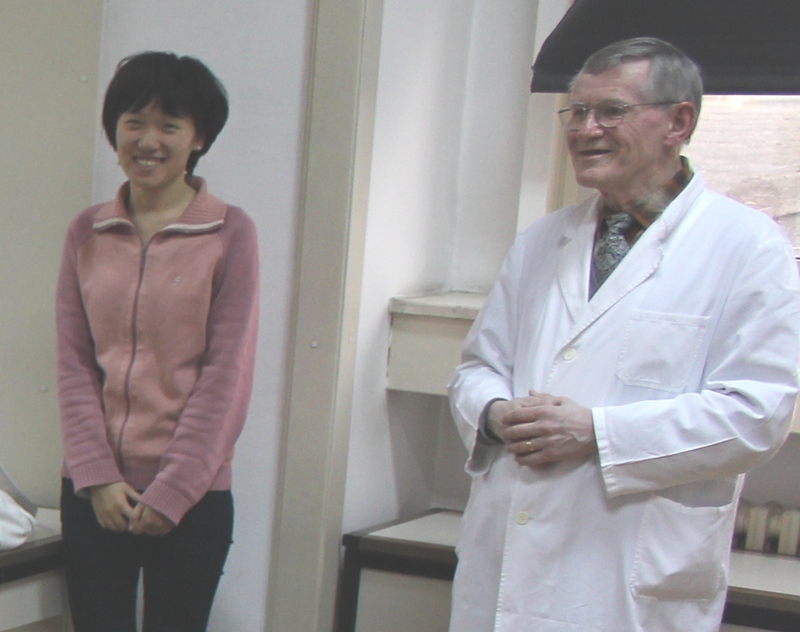
Professor Vladimir Ćepulić is assisted by a native speaker Ms Wei Ai from China.
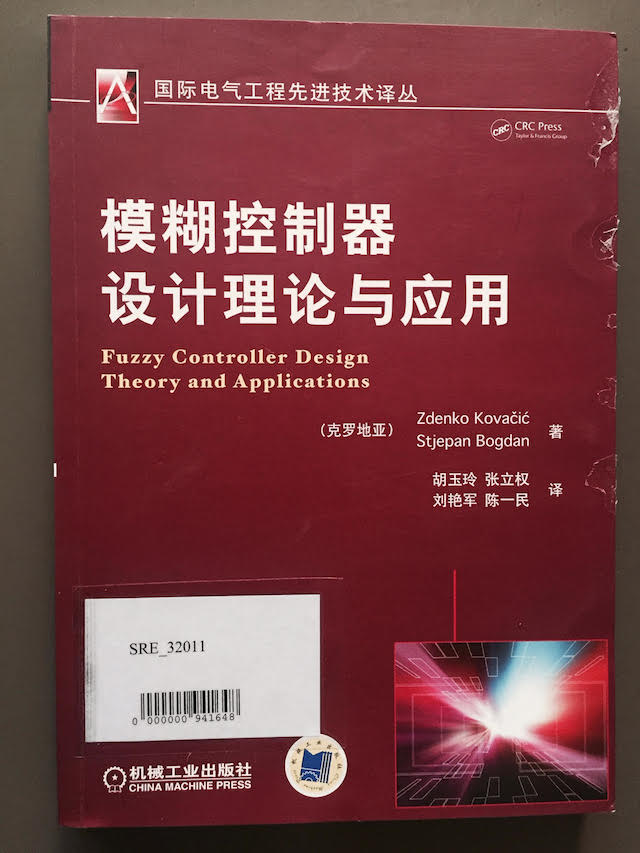
Chinese edition of the monograph by two Croatian scientists Zdenko Kovačić and Stjepan Bogdan,
employed at the University of Zagreb, Faculty of Electrical Engineering and Computing (FER).
Many thanks to Mrs. Jadranka Lisek from the Library of FER, for her kind information.
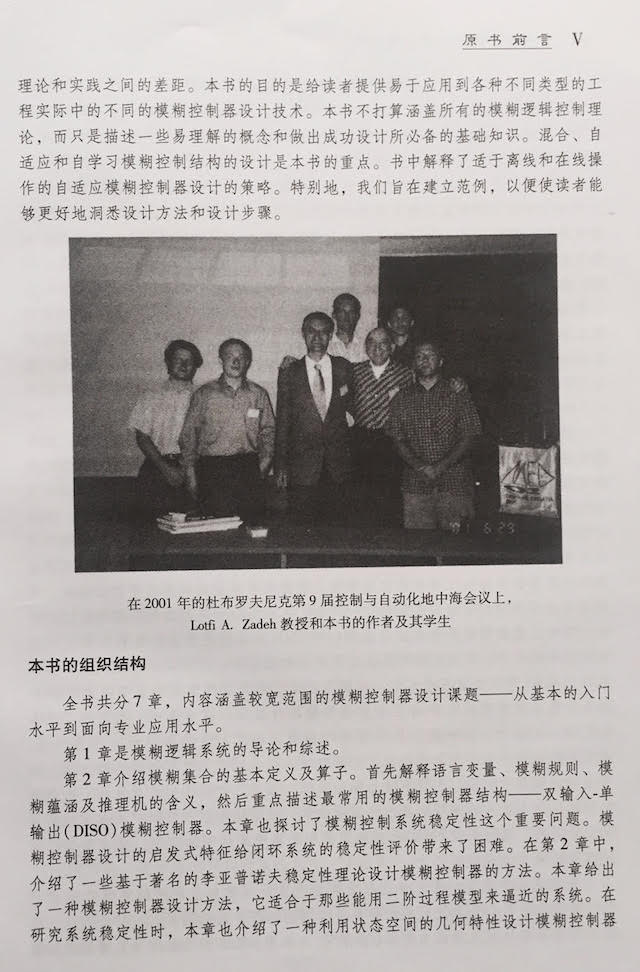
LARICS researchers at the Chinese Academy of Sciences

Chinese
dolls Fuwa, official
dolls of the 2008
Olympic Games in Bejing: their names are
Beibei,
Jingjing, Huanhuan, Yingying and Nini.
Many thanks to Mrs. Teresa Perinić, Croatian living in Buenos Aires, daughter of the King of Dolls, for sending me these photos of the dolls that she got as a gift in 2011 from Mr Han Mengtang, attaché of cultural affairs at the Embassy of the People's Republic of China in Argentina.
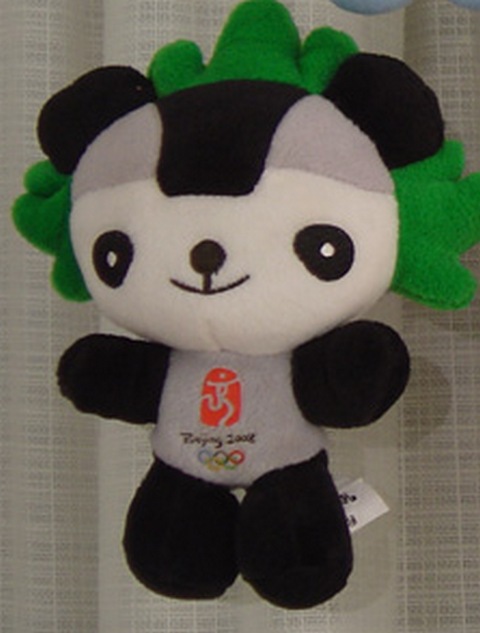
Croatian program of China Radio International CRI is issuing a representative journal in Croatian language, entitled Zlatni Feniks - Glas CRI (Golden Phenix - The Voice of CRI)
Konfucijev institut Sveučilišta u Zagrebu
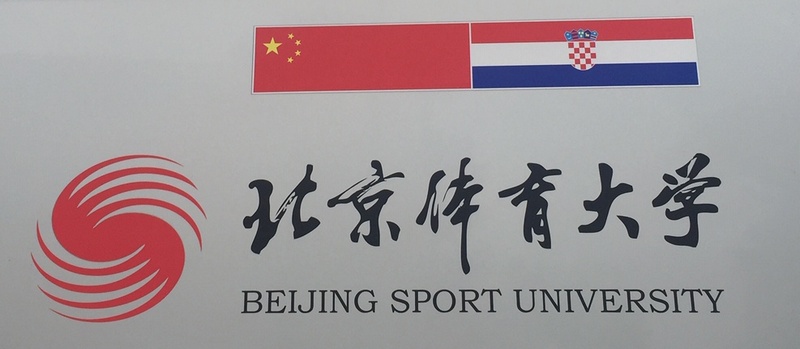
Bejing Sport University has collaboration with Croatian sports institutions, with emphasis on handball, water-polo and football.
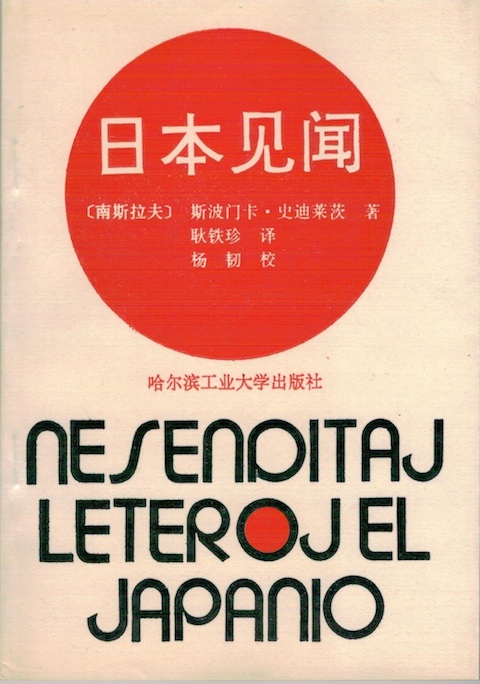
(i.e., Nonsent Letters from Japan), in Chinese from Esperanto,
University of Harbin (originally published in esperanto and printed by Hukuoka in Japan).
This book served for students of japanology at Harbin.
For more information, see
- Izložba knjiga - Libroekspozicio: 200 godina hrvatske književnosti na esperantu - Cent jaroj de kroata literaturo en Esperanto, Zagreb 1908.-2008. (and in particular, p. 21 of the following article by Spomenka Štimec, "Prijevodi hrvatske književnosti na esperanto od 1997. do 2008. / Translations of Croatian literature into Esperanto from 1997 to 2008", appearing in the same booklet on pp. 20-25).
- Esperanto Croatian-League in Zagreb
Croatia - Australia
Croatia - Japan Croatia - South America
Croatia - its History, Culture and Science



